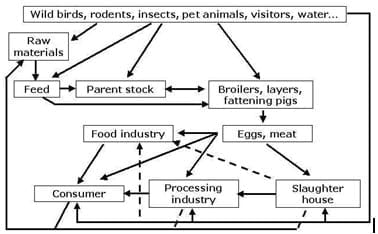Part III- Simple strategies to avoid Salmonella outbreaks
Salmonella is a pernicious pathogen and eradicating it entirely from the food chain is difficult. Despite our best efforts to eradicate it from the food chain, it can still cause expensive and devastating losses - of productivity and of human life
Yet another case of human salmonellosis has been reported in the USA, traced back to ground turkey meat. The fact that this contamination was found in meat from a major poultry integrator further emphasises the need for effective control measures from farm to fork
Central to Salmonella control in the food chain is proper biosecurity. However, biosecurity alone has not proved sufficient to prevent infection. There are numerous routes of infection in the poultry production chain (outlined in Figure 1) - and Salmonella can take full advantage of them. Therefore, integrated approaches are needed. In the past, antibiotic growth promoters played an important role, as discussed previously ("Antibiotic resistance from farm to fork"), but the issue of resistance is making this strategy increasingly less effective, not to mention controversial
However, the concept of protecting the animal from infection through the feed should not be discarded. Progressive research shows that other feed additives, among them organic acids, are both reliable and safe
Since the 1980´s, reports have shown organic acids, and formic acid in particular, to be especially effective against Salmonella, when used in poultry diets. The use of pure formic acid in breeder diets reduced the contamination of tray liners and hatchery waste with S. enteritidis drastically (Humphrey and Lanning, 1988). By 1990, researchers in the US found significantly reduced levels of Salmonella spp. in carcass and caecal samples, after including calcium formate in broiler diets (Izat et al., 1990). Further research (Kovarik and Lojda, 2000) reported that formic acid at 0.5% in the diet can be successfully used on farms to reduce salmonella contamination in feed, excretion of Salmonella spp. and re-infection of chicken populations
The scientific literature is full of such reports, but in practice, a number of more practical issues will sort out the effective acidifiers from the rest. Pure formic acid, however effective in feed, is also corrosive, hazardous, as well as volatile - it is literally too difficult to handle in the feed mill. Furthermore, while producing pelleted poultry feed, you can expect losses of more than 20% of the acid. Often, these liquid and volatile acids have also only antibacterial effects in the feed and the foregut of the birds. More recently, research has focused on overcoming these limitations. Chemical compounds which are heat-stable, non-corrosive and yet still effective are the way forward. Diformates, like sodium diformate (Formi NDF, ADDCON) satisfy these industry requirements. An organic acid salt by nature, it combines the strength of formic acid, but its physical properties (crystalline, non-volatile) mean that it can be used safely in the feed mill, as well as being effective in the feed and in the animal
Furthermore, tests against intestinal pathogens, including Salmonella, have shown diformates to have significant antimicrobial activity in broiler chickens (Table 1). Keeping bacterial pathogens under control reduced the probability of causing a disease outbreak, but given that intestinal infections are one of the major causes of productivity loss in the poultry industry, it is no surprise that sodium diformate has also proved effective in improving growth performance and reducing mortality in broilers
Table 1. Results of various sodium diformate (Formi NDF) dosages on Salmonella inhibition (% positive samples). Lückstädt and Theobald, 2009

Figure 1. Infection routes of Salmonella in animal production (Adapted from Oostenbach, 2004)




ساحة النقاش